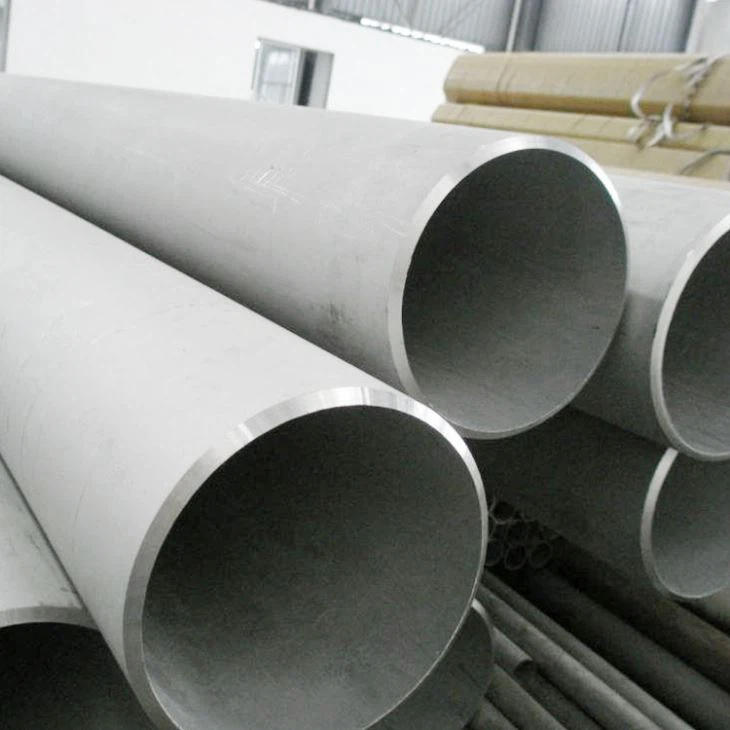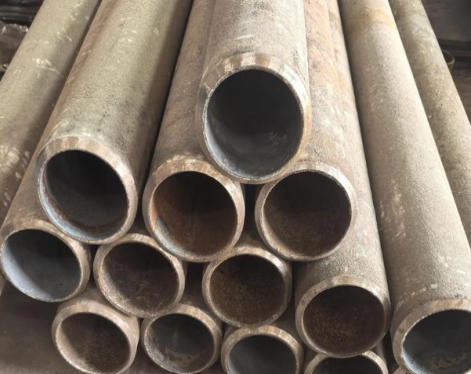With the development of industrialization, large-diameter seamless steel pipes are used more and more widely, and their scope of use covers many fields such as petroleum, natural gas, chemical industry, and construction. In the processing of steel pipes, cutting is a very important step. This article will introduce the cutting method of large diameter seamless steel pipe.
1. Cutting tools
Cutting tools are one of the most important pieces of equipment in the cutting process, as they can affect the effect and quality of cutting. Commonly used cutting tools on the market include flame cutting, plasma cutting, laser cutting, etc.

Flame cutting is the earliest cutting method developed. Its principle is to mix oxygen and gas and ignite them to form a high-temperature flame, and the steel pipe is cut through the heat energy of the flame. Flame cutting is suitable for cutting thicker steel pipes, but its cutting speed is slow and it is easy to produce oxide scale.
Plasma cutting is performed in high-temperature plasma. Its cutting speed is faster than flame cutting, but it requires the use of a high-voltage plasma generator, which is costly.
Laser cutting is a high-precision cutting method. Its principle is to use a laser beam to cut steel pipes. It has the characteristics of fast cutting speed and high precision, but the equipment is expensive.
2. Preparation before cutting
Before cutting large-diameter seamless steel pipes, some preparations are required. First, the cutting direction and cutting length need to be determined to avoid wasting steel pipes. Secondly, the surface of the steel pipe needs to be cleaned to remove scale and dirt so that the cutting tool can cut better.
3. Cutting skills
(1) Flame cutting
Flame cutting requires mastering the size of the flame and the flow of gas, so as to ensure the cutting speed and effect. When cutting, the flame needs to stay on the surface of the steel pipe briefly to allow it to form a layer of slag, and then use a cutting tool to cut it. Keep it level when cutting and avoid cutting too deep or too shallow.
(2)Plasma cutting
Plasma cutting requires mastering the density and flow rate of the plasma, as well as the cutting speed. During cutting, the plasma needs to stay on the surface of the steel pipe briefly to melt it, and then use a cutting tool to cut it. Keep it level when cutting and avoid cutting too deep or too shallow.
(3)Laser cutting
Laser cutting requires mastering the density and speed of the laser beam, as well as the cutting depth. When cutting, the laser beam needs to stay on the surface of the steel pipe briefly to melt it, and then use a cutting tool to cut it. Keep it level when cutting and avoid cutting too deep or too shallow.
4. Post-cutting processing
After cutting, the steel pipe needs to be processed to remove the burrs and slag produced during cutting to make its surface smooth. This can be done with a sander or other tools.
In short, large-diameter steel pipe cutting is a very important step. It is necessary to choose appropriate cutting tools and master cutting skills to ensure cutting effect and quality. At the same time, the steel pipe needs to be processed after cutting to make its surface smooth for subsequent processing.
1. Cutting tools
Cutting tools are one of the most important pieces of equipment in the cutting process, as they can affect the effect and quality of cutting. Commonly used cutting tools on the market include flame cutting, plasma cutting, laser cutting, etc.

Flame cutting is the earliest cutting method developed. Its principle is to mix oxygen and gas and ignite them to form a high-temperature flame, and the steel pipe is cut through the heat energy of the flame. Flame cutting is suitable for cutting thicker steel pipes, but its cutting speed is slow and it is easy to produce oxide scale.
Plasma cutting is performed in high-temperature plasma. Its cutting speed is faster than flame cutting, but it requires the use of a high-voltage plasma generator, which is costly.
Laser cutting is a high-precision cutting method. Its principle is to use a laser beam to cut steel pipes. It has the characteristics of fast cutting speed and high precision, but the equipment is expensive.
2. Preparation before cutting
Before cutting large-diameter seamless steel pipes, some preparations are required. First, the cutting direction and cutting length need to be determined to avoid wasting steel pipes. Secondly, the surface of the steel pipe needs to be cleaned to remove scale and dirt so that the cutting tool can cut better.
3. Cutting skills
(1) Flame cutting
Flame cutting requires mastering the size of the flame and the flow of gas, so as to ensure the cutting speed and effect. When cutting, the flame needs to stay on the surface of the steel pipe briefly to allow it to form a layer of slag, and then use a cutting tool to cut it. Keep it level when cutting and avoid cutting too deep or too shallow.
(2)Plasma cutting
Plasma cutting requires mastering the density and flow rate of the plasma, as well as the cutting speed. During cutting, the plasma needs to stay on the surface of the steel pipe briefly to melt it, and then use a cutting tool to cut it. Keep it level when cutting and avoid cutting too deep or too shallow.
(3)Laser cutting
Laser cutting requires mastering the density and speed of the laser beam, as well as the cutting depth. When cutting, the laser beam needs to stay on the surface of the steel pipe briefly to melt it, and then use a cutting tool to cut it. Keep it level when cutting and avoid cutting too deep or too shallow.
4. Post-cutting processing
After cutting, the steel pipe needs to be processed to remove the burrs and slag produced during cutting to make its surface smooth. This can be done with a sander or other tools.
In short, large-diameter steel pipe cutting is a very important step. It is necessary to choose appropriate cutting tools and master cutting skills to ensure cutting effect and quality. At the same time, the steel pipe needs to be processed after cutting to make its surface smooth for subsequent processing.









